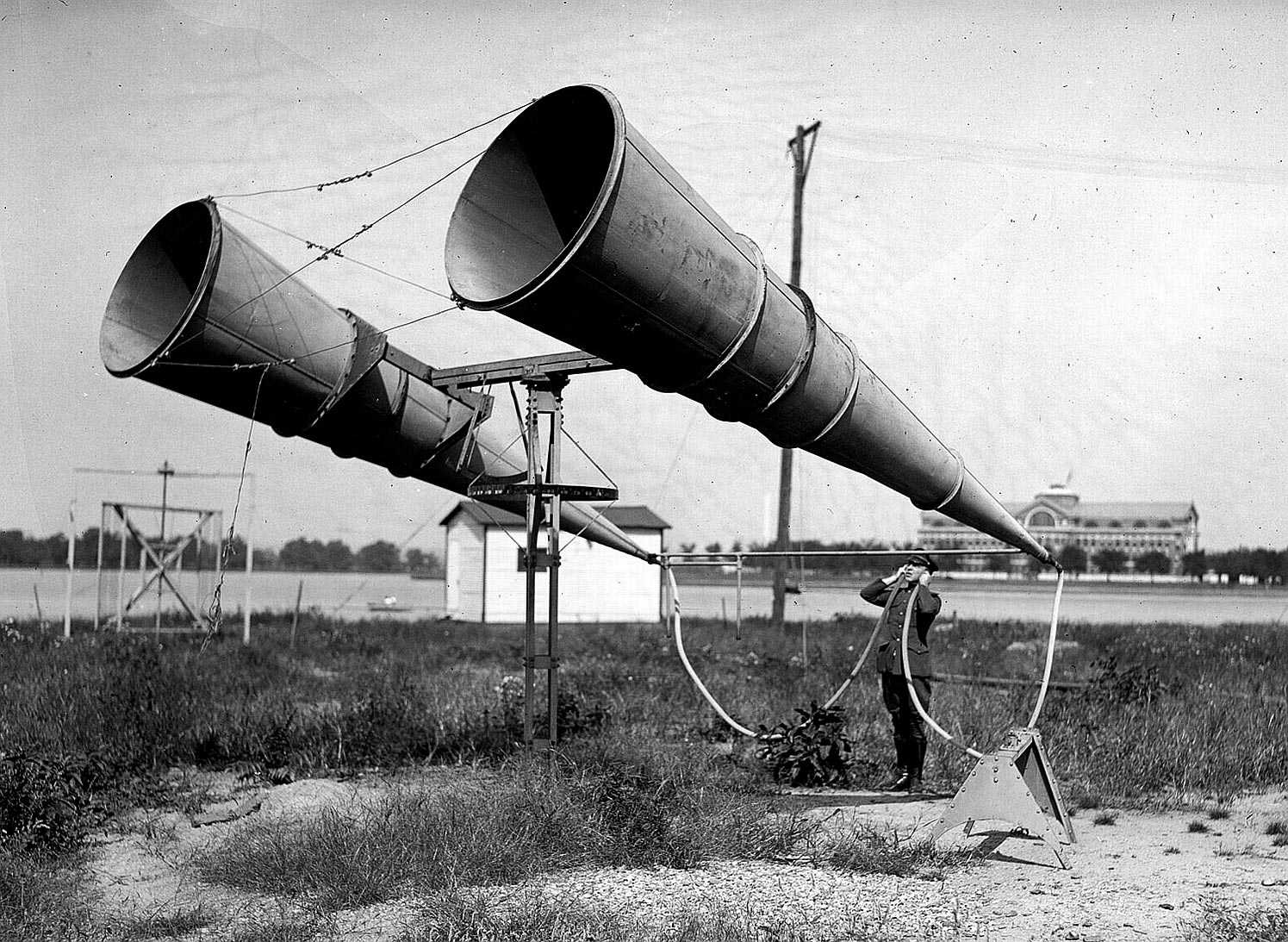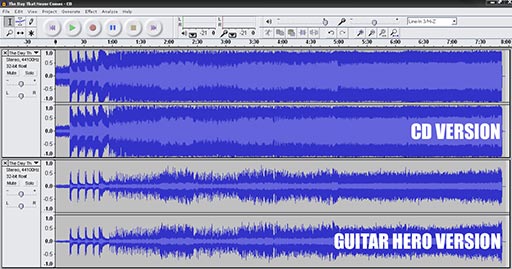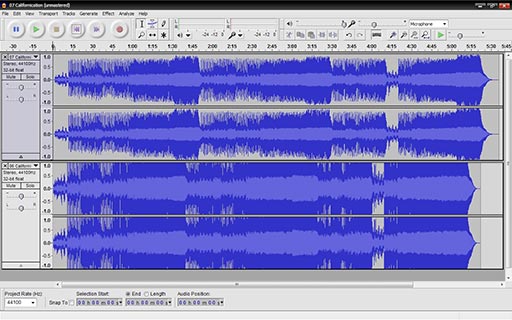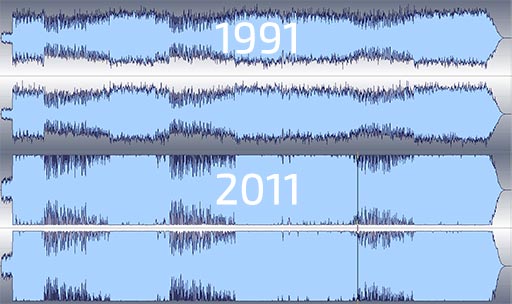Loudness war
A bloodless war of which victims are consumers

Introduction

The loudness war has distant origins. The first rumblings of this phenomenon occured when audio CD was created, although, it was a dead certain when vinyl became the first means of music mass distribution. Record companies, in order to spread the most important songs of their major artists, published 45 rpm records that were played in jukeboxes in bars around town.
The jukebox had a fixed output volume that was set by the owner of the premises, but the records that had a higher recording level compared to other got more attention from the public. The belief that Louder is better has influenced many people within the record industry eventually creating many unsuspecting victims. The first among these were certainly occasional listeners or those who are more distracted so that over the years they have represented the highest number of buyers. In order to help you better understand what I mean, try to carry out a small test. Make a group of people listen to a song at a certain volume or sound pressure level. Then repeat the same song at a higher volume than the first time. Nine times out of ten you will be told that the song sounds better when played at a higher volume. If you try to ask why, you will be told that listening is more immersive and exciting. That may be true, but beyond that which can only be described as a subjective feeling, there are also specific technical and scientific reasons. Let’s look at them more closely.
As regard technical reasons, it should be noted that the majority of amplifiers, speakers and headphones, with volume increase or decrease, do not reproduce all frequencies at the same level. Very low volumes can give the impression that the higher frequencies and lower ones are stronger than medium ones. Otherwise, as soon as you raise the volume to normal listening levels or higher, you can hear the entire range of frequencies more evenly, with the distinct impression that the song has a greater impact and effectiveness. The scientific reasons being that, the human ear can hear frequencies ranging between a minimum of 20 Hz to a maximum of approximately 20 kHz, although the latter limit decreases progressively with age. In this range of frequencies, the ear turns out to be more sensitive to sounds between 1 and 5 kHz, also thanks to the resonance of the ear canal and the transfer function of the ossicles of the middle ear. In this way, the volume also increases the perception of the frequency range in which the human ear is most sensitive, giving the listener the feeling that everything sounds better and with greater presence.
Victims and slaughterers

If we had to identify victims and slaughterers in the loudness war, we should definitely include on the one hand the dynamic range of music and on the other hand musicians and marketing managers of record labels. The dynamic range of music is the range between the maximum peak level produced by a sound and the minimum intensity produced by such sound. To achieve higher levels of volume you should reduce drastically this range by using a process called compression. As quoted from Wikipedia:
Dynamic range compression, also called DRC (often seen in DVD and car CD player settings) or simply compression reduces the volume of loud sounds or amplifies quiet sounds by narrowing or “compressing” an audio signal’s dynamic range. Compression is commonly used in sound recording and reproduction and broadcasting and on instrument amplifiers. The dedicated electronic hardware unit or audio software used to apply compression is called a compressor. Compressors often have attack and release controls that vary the rate at which compression is applied and smooth the effect.
Downward compression reduces loud sounds over a certain threshold while quiet sounds remain unaffected. Upward compression increases the loudness of sounds below a threshold while leaving louder passages unchanged. Both downward and upward compression reduce the dynamic range of an audio signal.
Having said that, we should try to explain more clearly why during the loudness war, the dynamic range has become the main victim of perpetrators such as artists, marketing managers and to some degree, sound engineers. In order for the music produced and recorded to always be higher, dynamic range compression is used more often in mastering causing, however, dynamic range flattening that can easily be detected in modern music. This is done not only to follow the latest trends in technology, but mainly because of concerns about a possible negative commercial impact should the recording sound lower than other songs in the charts. Therefore a whole range of devices, often of poor quality, are used by many artists trying to make the volume of their songs as high as possible at the expense of high fidelity. The result is a race in which there are no rules but only one goal, to play your record at a volume higher than anyone elses. A race that over the years, in our opinion, has just made things worse without any winners or losers, and that has ended up creating the modern paradox of an equation in which the increase of the quality of the recording devices and of digital technology has been offset by killing, or rather flattening the overall quality of recorded music.
With rare exceptions (taking into account albums and also internationally renowned artists), many records have expensive productions behind them in terms of technology and timing but which in practice are not very effective from a sonic point of view because of their frantic search for loudness. In addition, and here lies the paradox, the use of today’s music has dramatically helped this harmful tendency to raise volume. The birth of smaller and transportable music players has ended up putting the listener in noisier environments such as streets full of traffic and city centers. We refer to the various iPods and portable media players that reproduce compressed audio files such as MP3. The spread of their use has prompted record labels to provide users with tracks with increased volume to avoid a poor judgment or little impact on what they have bought from digital music multiple distribution platforms, even if over the years it has been seen that there’s no link in practical and economic terms between the increase in volume of a song and the number of sales of the same. We therefore believe that all this is merely the result of marketing managers’ unwarranted fears or those of certain uneducated artists about the real performance of the music market. Obviously, by limiting and compressing the dynamic range, you’ll always cause some damage to the song. If that wasn’t the case, people wouldn’t complain about it and wouldn’t point the finger at a specific category such as mastering engineers who, in order not to lose many customers feel obliged to follow the whims of record labels and artists during the finalizing process of a record.
So is there really a loudness war? To answer this question properly, it would be useful to adopt the same method used in image processing, where an image is analyzed based on the luminance distribution with an algorithm that makes scanning all the pixels and sorts them according to their brightness. The result is a distribution diagram that indicates whether the image, as a whole, includes light areas, medium or darker ones and to what extent. The same process can be performed with music; take the example of a scan of all the samples of a song and sort them in accordance with their absolute level. If we analyze today’s songs in the charts using this method we would end up seeing images or surfaces that are too light or bright. Similarly with music from the last 20 years, the images that we would ultimately derive would be progressively clearer with a sharp increase in brightness in the most recent recordings. This feature can be observed mainly in modern music, where more brilliance not only means a higher density of bright pixels but also a significantly reduced dynamic range, which is indicative of a heavily modified waveform and in the worst cases, distortion. Although in theory there is nothing wrong with this, common sense would suggest that this feature should not be the common denominator of existing recordings of pop or rock music.
Reported cases

Here have been several reported cases of the loudness war over the years. We talk about records being victims of wild compression and limiting in the mastering stage. Many have become the subject of bitter criticism by both audiophiles and common listeners in online petitions where people claim that the record should have being remastered at lower levels. The musical media most affected by this phenomenon was definitely the audio CD. In the eighties CDs were not the primary means of dissemination of music on a large scale, and there was, at least then, no particular reason for pushing the levels of the recordings. In the nineties, however, this trend has changed and CDs with high recording levels began to spread quickly. This is also thanks to the introduction of the digital brickwall limiter. A brickwall limiter is basically a compressor that has a very high compression ratio, of 20:1 and also a time attack that is extremely fast. Since the audio signal, at least in the digital domain, can not exceed 0 dBFS using a limiter with a maximum output level set just below zero, it can be reduced drastically in the dynamic range where there’s almost no difference between the sections with lesser or greater volume. Since the volume of a digital audio track is not infinite, but limited to a certain threshold such as 0 dBFS beyond which the signal is clearly distorted, the only way to increase the perceived loudness, once you reach that threshold, is to compress the signal with a brickwall limiter. In this way we reduce the peak dynamics, which almost always correspond to the kick and snare hits, raising all that is between them and at the same time flattening the transients. This technique has also been used in the past, but always in a rather moderate way.
Today, unfortunately, things have changed and it’s unthinkable to produce a record without first subjecting it to heavy dynamic range compression. The first victim of such treatment is music because the dynamics of sound is dramatically reduced, leveling the language of music itself, standardizing it and thus causing it to lose its high intrinsic value. Although clearly questionable, this method is acceptable for certain genres of music such as dance or techno or pop songs that have no ambition to last more than one season. However, if the goal of both the artist and producer is to create something that will last over time and be considered a classic or something that people will listen to in the future, then the use of heavy compression is very harmful because by playing down the shades and turning the song into a single block, the sound will immediately become unappealing. Even after a few minutes, it will be possible to experience some fatigue because our ears and our minds need the nuances and the details to maintain attention and interest. The growing musical dynamics, from pianissimo to fortissimo passages are part of our musical background since the introduction of the first home stereo systems. The primary purpose of recorded music has always been to record the performance of an artist, whether in the studio or live, with the highest quality and fidelity. In this regard, we don’t want to embark on nostalgic speeches, but simply we want to take a clear stance widely shared by those who truly love music and make it the soundtrack of their lives.
Unfortunately so many artists and producers today don’t think that excessive use of compression and brickwall limiters are a danger to their musical productions. According to the dictates of the loudness war, his unrestrained search for volume is also very often used in the mastering stage in order to increase the gain of a few decibels of the final track. However, not only have audiophiles started fighting in the loudness war but also very famous artists who have labored to try to go against this damaging trend. Even someone like Bob Dylan was moved to declare:
You listen to these modern records, they’re atrocious, they have sound all over them… …There’s no definition of nothing, no vocal, no nothing, just like …static.
This is what many buyers thought in 2008 when the famous album by Metallica titled Death Magnetic was published. The level of recording of the record was so high that the album has quite a saturated sound whether it’s played on a laptop computer using a headset or an expensive stereo system. For this reason we have encountered strong reactions and negative comments from everywhere to the point that many fans have started an online petition to remaster the album. Even Ted Jensen who took care of the mastering of the album stated:
I’m certainly sympathetic to your reaction, I get to slam my head against that brickwall limiter every day. In this case the mixes were already brick walled before they arrived at my place. Suffice it to say I would never be pushed to overdrive things as far as they are here. Believe me I’m not proud to be associated with this one, and we can only hope that some good will come from this in some form of backlash against volume above all else.
Going back a few years and more precisely to 1999, many fans complained about the low quality sound of the album Californication by Red Hot Chili Peppers released on CD. The volume on the CD is so high that the digital recording suffers from clipping in a clear manner that even the occasional listeners have protested against in the form of an online petition requesting the remastering of the album. Another case concerns an album that many people consider, and not just us, a true milestone in rock music. We’re taling about Nevermind by Nirvana. To celebrate the twentieth anniversary of the album, it was re-released in a remastered version. Unfortunately, and to our great disappointment, this beautiful record was a victim of the loudness war. The new remaster of Nevermind is a total disaster. The dynamics and transparency of the original release have vanished, transforming the entire album into a mess of sound. The impact between verse and chorus that made Nirvana famous disappeared completely, making each song flat from every aspect. The only advice we can give in such situations is to keep hold of the original 1991 CD release or the audiophile version published by MoFi.
Final thoughts

Some say that the dynamic range compression helps the quietest parts of a record to be listened to more easily in noisy environments such as in the car, or late at night without disturbing the neighbors. The musicians should always ask themselves: why their records need to be adapted to different listening situations? And why not implement a button that activates the dynamic range compression on the audio player, in the car or at home and let the user adjust it to his liking? It might be a viable solution to the above problem and could end the loudness war. The loudness war always ends with a one and only victim — music. When you avoid compressing individual songs in an obvious way, the dynamics of the individual instruments gives the music the right rhythmic propulsion, whether it’s a violin concert or reggae music. The sense of relaxation that ensues when listening, stands in sharp contrast to the stress generated by heavy compression. The wide dynamic range allows a deeper involvement in music, greater ability to hear all the musical parts providing a much more pleasant listening experience. The sense of space and the reconstruction of the soundstage are placed with greater emphasis, helping the listener to be brought closer to the recorded music event. Similarly the low frequencies remain more focused and have a greater impact and are not leveled out unlike most modern songs. Even electric guitars have a fighting spirit that gives them more presence, without causing them to dominate the rest of the instruments.
The sounds that play in the upper registers of the sound spectrum retain the harmonic sweetness that they achieve in real life, without the fatiguing process which accompanies the compression. The air around the musicians remains intact and gives breath to the whole record. There will always be those who actually use the compression as trademarks of their music productions should this be their ultimate goal. These people should understand, however, that there is merit in making records that sound like live music. The artists should forget once and for all that their records, even if mastered at high volumes, can play louder than the others on the radio. Robert Orban, CEO and Chief Engineer of Orban has something to say about that. Orban Industries equips most of the radio stations in the U.S.A. and in some parts of the world. When a record is aired on Orban radio equipment its audio signal undergoes further compression, a further process of limiting the dynamic range thereby conforming its volume to the rest of the music that is transmitted from the radio itself. In this way, also the audio signal at the lowest level is brought to the maximum and the one already heavily compressed undergoes a further compression. These devices are certainly not designed to make music sound better than it had been recorded originally. The radio broadcasting process removes all the dynamics of the music and the beginning of the song is played at the same volume as the refrain.
The higher the recording level of the original CD, the more compressed and distorted it’ll be once transmitted on air. To conclude we want to say that fortunately this loudness war is coming to an end thanks to the diffused awareness campaigns of websites such as Pleasurize Music and Turn me up!. Both are nonprofit organizations that gather together groups of artists and highly qualified professionals from the audio recording industry in order to publish high dynamic range records. At this point we would like to advise all artists, producers and sound engineers to avoid compression for the sole purpose of increasing the volume of their work because on all the stereo systems of this world, both those present at home and those in the car, have a knob that adjusts the volume. So whether you’re a professional or a casual listener, if you really want your music to be higher volume wise and with greater emotional impact, please, turn up that damned volume knob! Use it! Always!
Top







